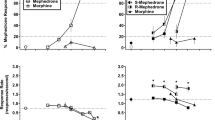Abstract
Rationale
Although the synthetic cathinone 4-methylmethcathinone (4-MMC, mephedrone) has been a subject of intensive research investigation, the pharmacological mechanisms involved in its interoceptive stimulus effects have yet to be fully characterized.
Objective
The present study employed drug discrimination methods in rats to compare the interoceptive stimulus properties of two different training doses of 4-MMC to other substances with similar pharmacological actions.
Methods
Sixteen male Sprague-Dawley rats were trained to discriminate either 1.0 mg/kg (N = 8) or 3.0 mg/kg (N = 8) 4-MMC from saline. Substitution tests were conducted with drugs that increase extracellular monoamine levels (d-amphetamine, (+)-methamphetamine, 4-MMC, MDMA, MDPV, and (−)-cocaine), a serotonin releaser (+)-fenfluramine, and a serotonergic (5-HT2A) hallucinogen (+)-LSD.
Results
Stimulus control was established in fewer sessions in the subjects trained with 3.0 mg/kg compared to those trained with 1.0 mg/kg 4-MMC. Cocaine, MDMA, and d-amphetamine produced full substitution in the 1.0 mg/kg 4-MMC-trained rats at doses that did not decrease response rate. However, doses of test drugs that engendered > 80% 4-MMC-lever selection concurrently produced rate-decreasing effects in rats trained to discriminate 3.0 mg/kg 4-MMC.
Conclusions
These findings further characterize the interoceptive stimulus effects of 4-MMC and indicate that these effects vary little with training dose; however, qualitative differences in substitutability of test drugs were observed between training groups. This study expands existing knowledge regarding the psychopharmacology of 4-MMC and the potential neurochemical substrates contributing to its subjective effects.


Similar content being viewed by others
References
Aarde SM, Deepshikha A, Barlow DJ et al (2013) Mephedrone (4-methylmethcathinone) supports intravenous self-administration in Sprague-Dawley and Wistar rats. Addict Biol 18:786–799. doi:10.1111/adb.12038
Baumann MH, Ayestas MA, Partilla JS et al (2012) The designer methcathinone analogs, mephedrone and methylone, are substrates for monoamine transporters in brain tissue. Neuropsychopharmacology 37:1192–1203. doi:10.1038/npp.2011.304
DeLarge AF, Erwin LL, Winsauer PJ (2017) Atypical binding at dopamine and serotonin transporters contribute to the discriminative stimulus effects of mephedrone. Neuropharmacology 119:62–75
Drug Enforcement Agency (DEA). (2011, October 21) Schedules of controlled substances: temporary placement of three synthetic cathinones into schedule I. Federal Register, 76(204), 65371–65375. U.S. Government Printing Office, Washington, DC
Gatch MB, Taylor CM, Forster MJ (2013) Locomotor stimulant and discriminative stimulus effects of ‘bath salt’ cathinones. Behav Pharmacol 24:437–447. doi:10.1016/j.drugalcdep.2014.02.188
German CL, Fleckenstein AE, Hanson GR (2014) Bath salts and synthetic cathinones: an emerging designer drug phenomenon. Life Sci 97:2–8
Hadlock GC, Webb KM, Mcfadden LM et al (2011) 4-Methylmethcathinone (mephedrone): neuropharmacological effects of a designer stimulant of abuse. J Pharmacol Exp Ther 339:530–536. doi:10.1124/jpet.111.184119
Harvey EL, Baker LE (2016) Differential effects of 3,4-methylenedioxypyrovalerone (MDPV) and 4-methylmethcathinone (mephedrone) in rats trained to discriminate MDMA or a d-amphetamine + MDMA mixture. Psychopharmacology 233:673–680. doi:10.1007/s00213-015-4142-4
Karlsson L, Andersson M, Kronstrand R, Kugelberg FC (2014) Mephedrone, methylone and 3,4-methylenedioxypyrovalerone (MDPV) induce conditioned place preference in mice. Basic Clin Pharmacol Toxicol 115:411–416. doi:10.1111/bcpt.12253
Kehr J, Ichinose F, Yoshitake S et al (2011) Mephedrone, compared with MDMA (ecstasy) and amphetamine, rapidly increases both dopamine and 5-HT levels in nucleus accumbens of awake rats. Br J Pharmacol 164:1949–1958. doi:10.1111/j.1476-5381.2011.01499.x
Khorana N, Pullagurla MR, Young R, Glennon RA (2004) Comparison of the discriminative stimulus effects of 3,4-methylenedioxymethamphetamine (MDMA) and cocaine: asymmetric generalization. Drug Alcohol Depend 74:281–287. doi:10.1016/j.drugalcdep.2004.01.005
Lisek R, Xu W, Yuvasheva E et al (2012) Mephedrone (‘bath salt’) elicits conditioned place preference and dopamine-sensitive motor activation. Drug Alcohol Depend 126:257–262. doi:10.1016/j.drugalcdep.2012.04.021
López-Arnau R, Martínez-Clemente J, Pubill D, Escubedo E, Camarasa J (2012) Comparative neuropharmacology of three psychostimulant cathinone derivatives: butylone, mephedrone, and methylone. Br J Pharmacol 167:407–420
Martinez-Clemente J, Escubedo E, Pubill D, Camarasa J (2012) Interaction of mephedrone with dopamine and serotonin targets in rats. Eur Neuropsychopharmacol22:231–236
Mayerhofer A, Kovar KA, Schmidt WJ (2001) Changes in serotonin, dopamine and noradrenaline levels in striatum and nucleus accumbens after repeated administration of the abused drug MDMA in rats. Neurosci Lett 308:99–102. doi:10.1016/S0304-3940(01)01992-9
Milewski AJ, Rawls S, Walker EA, Saber I (2017) Exploring the pharmacologic and discriminative effects of abused psychostimulants and the bath salt component mephedrone in rats. FASEB J 31:987.10
Motbey CP, Clemens KJ, Apetz N et al (2013) High levels of intravenous mephedrone (4-methylmethcathinone) self-administration in rats: neural consequences and comparison with methamphetamine. J Psychopharmacol 27:823–836. doi:10.1177/0269881113490325
Stolerman IP, Childs E, Ford MM, Grant KA (2011) Role of training dose in drug discrimination: a review. Behav Pharmacol 22:415–429. doi:10.1097/FBP.0b013e328349ab37
Valente MJ, Guedes de Pinho P, de Lourdes BM, Carvalho F, Carvalho M (2014) Khat and synthetic cathinones: a review. Arch Toxicol 88:15–45. doi:10.1007/s00204-013-1163-9
Varner K, Daigle K, Weed P, Lewis P, Mahne S, Sankaranarayanan A, Winsauer P (2013) Comparison of the behavioral and cardiovascular effects of mephedrone with other drugs of abuse in rats. Psychopharmacology 225:675–685. doi:10.1007/s00213-012-2855-1
Acknowledgements
This research was supported by a grant from the National Institutes of Health (R15DA038295). The National Institute on Drug Abuse drug control supply program provided several of the test drugs used in this study.
Author information
Authors and Affiliations
Corresponding author
Ethics declarations
All procedures were conducted in accordance with the Guide for the Care and Use of Laboratory Animals (2013) and were approved by the Institutional Animal Care and Use Committee at Western Michigan University.
Conflict of interest
The authors declare that they have no conflict of interest.
Rights and permissions
About this article
Cite this article
Berquist, M.D., Thompson, N.A. & Baker, L.E. Evaluation of training dose in male Sprague-Dawley rats trained to discriminate 4-methylmethcathinone. Psychopharmacology 234, 3271–3278 (2017). https://doi.org/10.1007/s00213-017-4716-4
Received:
Accepted:
Published:
Issue Date:
DOI: https://doi.org/10.1007/s00213-017-4716-4




